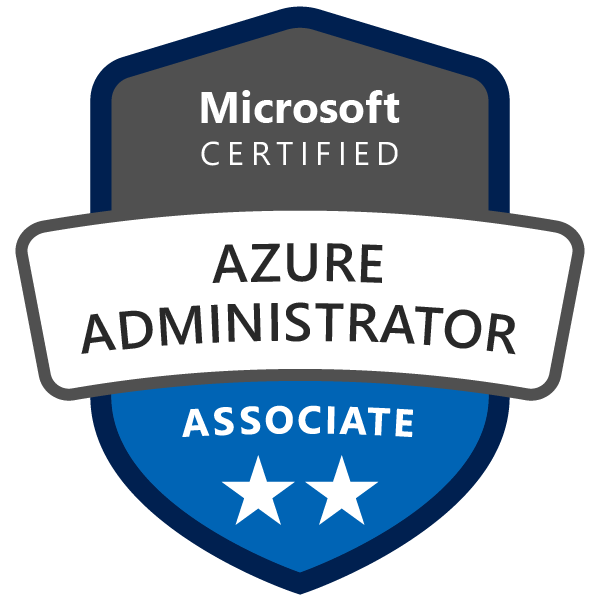AZ-104

| Formats: | Asynchronous |
| Blended | |
| Online | |
| Onsite | |
| Part-time | |
| Level: | Intermediate |
| Prerequisites: | |
| Recommended Knowledge | |
| Basic cloud concepts | |
| Awareness of core Azure Services | |
| General IT Knowledge | |
Formats: We offer our training content in a flexible format to suit your needs. Contact Us if you wish to know if we can accommodate your unique requirements.
Level: We are happy to customize course content to suit your skill level and learning goals. Contact us for a customized learning path.
Microsoft Azure Administrator (AZ-104)
The AZ-104: Microsoft Azure Administrator certification is designed to provide IT professionals with the knowledge and skills necessary to manage Azure resources and services. Throughout this training, participants will learn how to implement, manage, and monitor identity, governance, storage, compute, and virtual networks in a cloud environment. Additionally, the course covers configuring and managing virtual machines, managing Azure Active Directory, and implementing Azure load balancers and network security groups. By the end of the course, learners will be proficient in deploying and managing Azure compute resources, configuring and managing virtual networks, and ensuring effective backup and recovery strategies.
Job Opportunities
With the AZ-104 certification, professionals can pursue a variety of roles within the IT field. These roles include Azure Administrator, Cloud Administrator, Systems Administrator, and IT Support Specialist. In these positions, certified individuals are responsible for managing Azure subscriptions and resources, implementing and managing storage solutions, deploying and managing virtual machines, and configuring and managing virtual networks. The certification equips individuals with the skills required to handle operational aspects of cloud environments, making them valuable assets to organizations that rely on Azure for their cloud infrastructure.
Target Audience and Prerequisites
The AZ-104 certification is ideal for IT professionals who have experience with Azure and are responsible for managing cloud services that span storage, networking, and compute capabilities within the Microsoft Azure platform. The recommended prerequisites for this certification include a basic understanding of Azure services, general IT knowledge, and experience with PowerShell and the Azure Command-Line Interface (CLI). This certification is particularly beneficial for those looking to validate their expertise in Azure administration and enhance their career prospects. By obtaining the AZ-104 certification, individuals demonstrate their ability to manage Azure environments effectively, making them suitable candidates for a range of job opportunities in cloud computing and IT administration.
Course Objectives
Manage Azure identities and governance (15–20%)
Manage Azure AD objects
- Create users and groups
- Manage licenses in Azure AD
- Create administrative units
- Manage user and group properties
- Manage device settings and device identity
- Perform bulk updates
- Manage guest accounts
- Configure self-service password reset
Manage access control
- Create custom role-based access control (RBAC) and Azure AD roles
- Provide access to Azure resources by assigning roles at different scopes
- Interpret access assignments
Manage Azure subscriptions and governance
- Configure and manage Azure Policy
- Configure resource locks
- Apply and manage tags on resources
- Manage resource groups
- Manage subscriptions
- Manage costs by using alerts, budgets, and recommendations
- Configure management groups
Implement and manage storage (15–20%)
Configure access to storage
- Configure network access to storage accounts
- Create and configure storage accounts
- Generate shared access signature tokens
- Configure stored access policies
- Manage access keys
- Configure Azure AD authentication for a storage account
- Configure storage encryption
Manage data in Azure storage accounts
- Create import and export jobs
- Manage data by using Azure Storage Explorer and AzCopy
- Implement Azure Storage redundancy
- Configure object replication
Configure Azure Files and Azure Blob Storage
- Create an Azure file share
- Configure Azure Blob Storage
- Configure storage tiers
- Configure blob lifecycle management
Deploy and manage Azure compute resources (20–25%)
Automate deployment of resources by using templates
- Modify an ARM template
- Deploy a template
- Save a deployment as an ARM template
- Deploy virtual machine (VM) extensions
- Create and configure VMs
- Create a VM
- Manage images by using the Azure Compute Gallery
- Configure Azure Disk Encryption
- Move VMs from one resource group to another
- Manage VM sizes
- Add data disks
- Configure VM network settings
- Configure VM availability options
- Deploy and configure VM scale sets
- Create and configure containers
- Configure sizing and scaling for Azure Container Instances
- Configure container groups for Azure Container Instances
- Create and configure Azure Container Apps
- Configure storage for Azure Kubernetes Service (AKS)
- Configure scaling for AKS
- Configure network connections for AKS
- Upgrade an AKS cluster
Create and configure an Azure App Service
- Create an App Service plan
- Configure scaling settings in an App Service plan
- Create an App Service
- Secure an App Service
- Configure custom domain names
- Configure backup for an App Service
- Configure networking settings
- Configure deployment settings
Configure and manage virtual networking (20–25%)
Configure virtual networks
- Create and configure virtual networks and subnets
- Create and configure virtual network peering
- Configure private and public IP addresses
- Configure user-defined network routes
- Configure Azure DNS
Configure secure access to virtual networks
- Create and configure network security groups (NSGs) and application security groups (ASGs)
- Evaluate effective security rules
- Implement Azure Bastion
- Configure service endpoints
- Configure private endpoints
- Configure load balancing
- Configure Azure Application Gateway
- Configure an internal or public load balancer
- Troubleshoot load balancing
Monitor virtual networking
- Monitor on-premises connectivity
- Configure and use Azure Monitor for networks
- Use Azure Network Watcher
- Troubleshoot external networking
- Troubleshoot virtual network connectivity